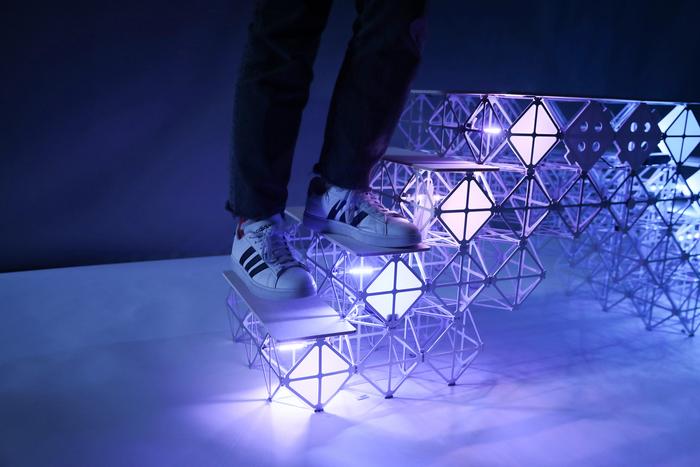
In the realm of engineering and design, a revolutionary shift is taking shape, underscored by advances in rapid prototyping technologies. MIT researchers are championing a groundbreaking platform known as the Voxel Invention Kit (VIK), which fundamentally changes the way interactive structures are conceived and created. Unlike traditional methods that often rely heavily on additive manufacturing processes such as 3D printing or laser cutting, VIK introduces an innovative approach with its lightweight, modular building blocks that possess integrated electronics—affording creators a seamless pathway to designing complex, interactive devices.
The arduous task of prototyping large structures laden with sensors and electronics typically involves a tedious cycle of trial and error. It is common for designers to fabricate multiple prototypes of a single device, each iteration racking up waste and resources that could have been conserved. In this context, the introduction of VIK represents a transformative shift, allowing practitioners to bypass these inefficiencies. By employing reconfigurable building blocks that integrate both structural and electronic components, VIK takes prototyping to the next level, paving the way for unprecedented design freedom.
At the heart of VIK lie the so-called voxels, three-dimensional lattice structures that are not only lightweight but also exhibit remarkable strength and stiffness. These functional building blocks come equipped with integrated capabilities for sensing, responding, and processing data, thus enabling users without advanced technical expertise to create sophisticated electronic devices. The voxels can be assembled in myriad configurations, facilitating an almost limitless array of structural possibilities. With a price point of approximately 50 cents per voxel, this innovation becomes both an accessible and practical tool for Creative Designers and Engineers.
Uniquely, the VIK platform incorporates a user-friendly design tool that allows for the simulation of structural responses to mechanical loads, enabling rapid iterations of design features. This gives designers the confidence to explore innovative ideas without the fear of wasting resources. Jack Forman, a graduate student at MIT and a co-author of the research, emphasizes this democratization of access to functional electronic devices. The VIK framework eliminates the need for specialized equipment typically found in making prototypes—users can utilize the voxel faces to construct these interactive structures in virtually any locale.
The voxel design itself is the result of years of research at the MIT Center for Bits and Atoms, leading to the creation of discrete building blocks that serve diverse functional purposes. One notable voxel is an aluminum cuboctahedral lattice, which boasts the intriguing ability to support substantial weight—up to 228 kilograms—as it integrates structural strength with functional capabilities. Focused on ease of use, the researchers have scaled up the voxel sizes to facilitate manual assembly, accompanied by enhancements such as aluminum cross-bracing that provides heightened stability and strength.
Moreover, the VIK voxels leverage a unique snap-fit connection that allows for quick assembly without requiring additional tools. This design decision diverges drastically from previous versions of vaults which relied on rivets, introducing a new level of convenience. As a result, users can trust that the connections they are making will yield the correct wiring harness for their respective designs, substantially reducing the risk of failure that often accompanies electrical connections in traditional prototypes.
The VIK initiative is also notable for its user interface, developed specifically to cater to those lacking extensive engineering backgrounds. Featuring a Finite Element Analysis (FEA) simulation model, users are equipped to visualize their creations and see how they would respond to various mechanical forces. By identifying potential failure points via colorful visual feedback, users can confidently proceed with their designs without requiring extensive knowledge in civil engineering. The intent, as expressed by Forman, is clear: create an interactive environment where experimentation and creativity flourish.
Easing the integration of off-the-shelf components is another significant facet of VIK, allowing creators to incorporate readily available modules like sensors or actuators into their projects. This flexibility encourages iterative development and aligns with the ethos of rapid prototyping, where users can easily modify the configuration of voxels or completely reassemble structures to accommodate new ideas. Furthermore, the recyclable nature of the aluminum voxels invites sustainable practices into the world of design, ensuring that when a device is no longer needed, its components can be returned to the production cycle instead of ending up in a landfill.
The application of VIK extends beyond merely functional prototypes; it holds the promise of transforming industries such as theater, aerospace, and urban development. The needs of stage managers looking for modular set pieces that adapt to the whims of theatrical performances align perfectly with VIK’s capabilities. Likewise, as space agencies explore the potential of fabricating parts in space, VIK stands as a feasible solution to manufacturing challenges that arise from traditional methods.
With an eye toward the future, the researchers express a keen interest in seeing VIK in action, urging users to put these innovative voxels to use in everyday life. The excitement surrounding this new prototyping platform suggests that its impact will resound across multiple disciplines, potentially altering not just how physical structures are made, but short-circuiting the barriers between ideas and their tangible manifestations.
In conclusion, the Voxel Invention Kit stands as a testament to how design and engineering are evolving in tandem with technological advancements. By harnessing the power of interactive, modular building blocks, the team at MIT is poised to usher in a new era of creativity and functionality in prototyping. It exemplifies a forward-thinking approach that prioritizes accessibility, sustainability, and collaboration—paving the way for anyone, regardless of technical expertise, to become a creator in their own right.
Subject of Research: Development of a rapid prototyping platform using modular, integrated electronics.
Article Title: MIT’s VIK: Revolutionizing Prototyping With Reconfigurable Voxels
News Publication Date: [Insert Date]
Web References: [Insert relevant links]
References: [Insert relevant references]
Image Credits: Jack Forman
Keywords
Tags: 3D lattice structuresdesign freedom in engineeringefficient prototyping methodsengineering innovationintegrated electronics in prototypinginteractive structures designlightweight structural componentsmodular building blocksrapid prototyping technologiessustainable design practicestransforming traditional manufacturing processesVoxel Invention Kit





